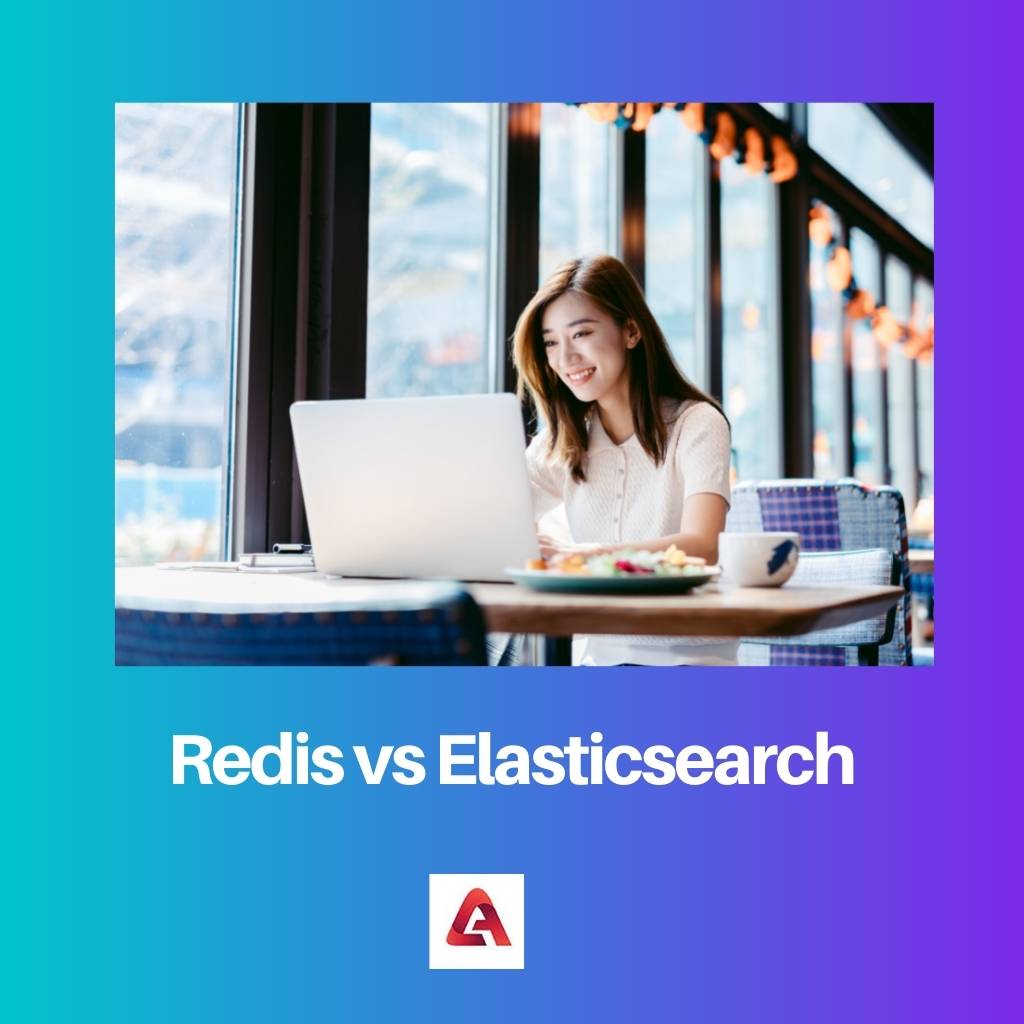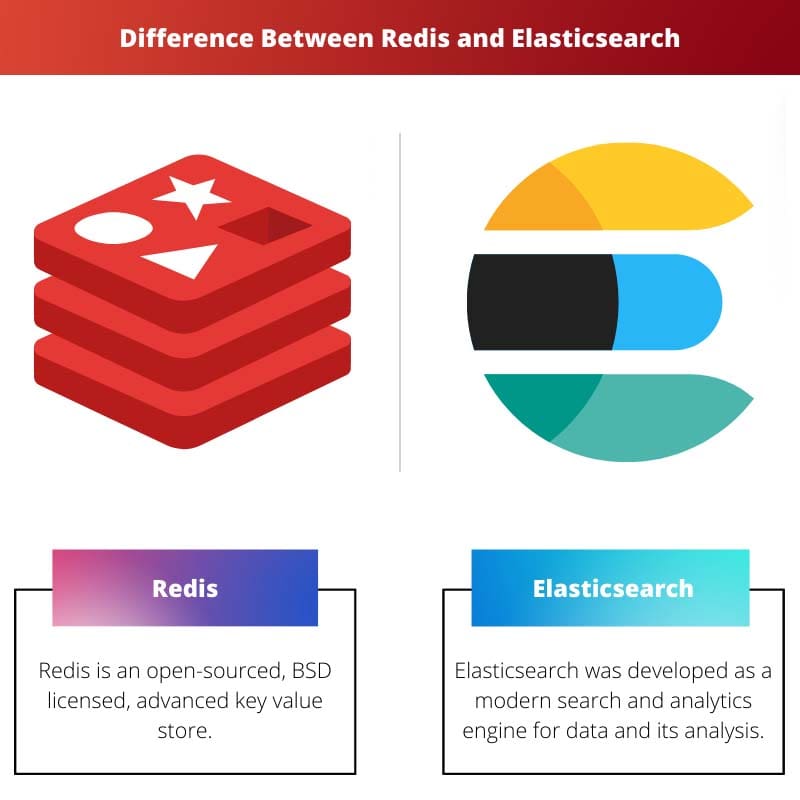Redis and Elasticsearch are two significant technologies for data solutions used in the IT field. These are versatile and flexible technologies that can be used for a variety of purposes.
Both have concrete differences between them, and there are different ways of integrating them into a program.
Key Takeaways
- Redis is primarily a data structure server, while Elasticsearch is a search engine.
- Redis is optimized for high-speed data access, while Elasticsearch is optimized for text-based search queries.
- Redis is used for caching, session management, and real-time messaging, while Elasticsearch is used for full-text search, logging, and analytics.
Redis vs Elasticsearch
The difference between Redis and Elasticsearch is that Redis is a data structure store that acts as a NoSQL Database. It is a popular in-memory data platform. Elasticsearch was developed as a search and analytics engine to store data and help in its analysis.

Redis can be used as a cache, data broker, and database. It can be deployed on-premises, across clouds, and in hybrid environments.
It is an open-source key-value store that was initially released in 2009. It offers a schema-free data scheme and is developed in the language C.
Elasticsearch is an open-source, distributed, modern search and analytics engine that offers real-time index search and analysis. Initially released in 2010, it was developed in Java and has a SQL-like query language.
It is capable of executing multitenant searches. Elasticsearch uses an HTTP web interface and is self and schema-free.
Comparison Table
| Parameters of Comparison | Redis | Elasticsearch |
|---|---|---|
| Definition | Redis is an open-sourced, BSD licensed, advanced key value store. | Elasticsearch was developed as a modern search and analytics engine for data and its analysis. |
| Memory Technology | It runs natively on DRAM and persistent memory. | It is disk-based with caching option. |
| Programming Language | It is C-based and is extremely optimized. | It is developed in Java. |
| Protocol | It uses the optimized RESP (REdis Serialization Protocol). | It uses HTTP. |
| Performance | Redis tends to be faster than Elasticsearch while indexing and when performing searches on the indexed data set. | It is a great feature-rich search product but has a lower performance compared to Redis. |
What is Redis?
The primary database model of Redis was that of a key-value store. But the secondary database models included different types of DBMS, document store and a search engine.
Redis is supported on almost all the major server operating systems like Linux, Windows, BSD, etc. Redis has eventual consistency and follows the partition method of sharding.
It is used by large enterprises, startups, and government organizations.
Common use cases include real-time fraud detection, global user session management, real-time inventory management, feature store for AI/ML, claims processing, and more.
Typical application scenarios of Redis include:
- Real-time analytics
- Caching
- High-speed transaction
- Distributed messaging
- Data ingest, etc.
Some of the notable customers are Vodafone, Samsung, Nokia, Trip Advisor, etc.
Redis uses the RESP( REdis Serialization Protocol) for TCP connections within it. Apart from eventual consistency, strong consistency can be achieved by using Redis raft, and strong eventual consistency can be achieved by using Active-Active and its databases.
An advantage of Redis is that it can be deployed anywhere and can be managed by public clouds, multi-cloud, and other hybrid architectures to ensure that the data can be accessed from anywhere without any lock-in.
Redis was the most loved database for four years in a row, according to the Stack Overflow Annual Developer survey. It was also termed as one of the 20 fastest-growing technical skill sets in 2020.
What is Elasticsearch?
Elasticsearch stores data in the form of indexes and provides powerful searching capabilities. It is developed in Java and hence, is supported in all Operating Systems with Java.
It is available for free under Apache 2.0 License, which also offers paid consulting services. In addition to offering real-time index search and analysis, other advantages of Elasticsearch include its being a distributed, resilient, and horizontally scalable engine.
The primary database model included only a search engine, while its secondary database models included spatial DBMS and a Document Store.
Elasticsearch uses a powerful API called RESTful API that uses an HTTP web interface. Elasticsearch, along with Logstash and Kibana, forms the ELK Stack, which is a popular software stack for managing and transporting data.
These tools are not just used by developers alone but also by data analysts and engineers.
The common case uses of Elastic search include search experiences for workplaces, websites, and apps; observability of APM, logging, metrics, and uptime. It also offers security and is used in Endpoint and SIEM.
Many world-famous organizations use Elasticsearch to power their critical systems. Some of them are Cisco, eBay, Wikipedia, Goldman Sachs, NASA, Microsoft, and The New York Times.
Main Differences Between Redis and Elasticsearch
- Redis is an open-sourced, advanced key-value store, while Elasticsearch is a distributed, RESTful modern search and analytics engine based on Apache Lucene.
- Redis natively runs on Dynamic-RAM and Persistent Memory. Elasticsearch has disk-based memory with caching option.
- Redis is developed in language C and is highly optimized. Elasticsearch is developed in Java.
- Redis uses the optimized RESP(REdis Serialization Protocol), while Elasticsearch uses an HTTP web interface.
- Redis tends to be faster than Elasticsearch when it comes to indexing and performing searches on the indexed dataset. Even though Elasticsearch is a feature-rich search product compared to Redis, it has a lower performance than Redis.

- https://www.net.in.tum.de/fileadmin/TUM/NET/NET-2017-05-1.pdf#page=49
- https://books.google.com/books?hl=en&lr=&id=OANwDQAAQBAJ&oi=fnd&pg=PP1&dq=redis+and+elasticsearch&ots=D7UAgrWKes&sig=Fx6FGOd1rPSnNZ_Op4B-jxJda9E
- https://books.google.com/books?hl=en&lr=&id=d19aBgAAQBAJ&oi=fnd&pg=PR3&dq=elasticsearch&ots=NAe_rSyshC&sig=8oovVg7DsCVCS-nYiG6BXmt4Nuo

The article effectively outlined the differences between Redis and Elasticsearch in terms of their utility and programming languages. It’s a valuable resource for those seeking clarity on these two technologies.
I echo the sentiments. The article’s analysis of performance and primary database models offered a comprehensive view of the capabilities of Redis and Elasticsearch.
I found the discussion on the memory technology and protocol used by Redis and Elasticsearch to be particularly insightful. It underscores the unique design and functionality of each platform.
The breakdown of Redis and Elasticsearch’s features and applications was thorough and informative. It’s a valuable resource for professionals looking to leverage these technologies effectively.
I agree with the assessment. The article effectively highlighted the key strengths of Redis and Elasticsearch and outlined their unique contributions to different domains.
I found the comparison of common use cases of Redis and Elasticsearch to be particularly illuminating. It provided insight into the practical applications of these platforms.
The article’s detailed analysis of Redis and Elasticsearch’s utility and real-world applications was incredibly informative. It offers a valuable perspective for individuals navigating these technologies.
I echo the sentiment. The comprehensive overview of Redis and Elasticsearch in diverse applications adds significant depth to our understanding of these technologies.
This is a clear and concise comparison of Redis and Elasticsearch. Both technologies are incredibly versatile and I appreciate the detailed information on their differences. Thank you for the insightful article.
I completely agree. The comparison table is very helpful for understanding the differences in key features between Redis and Elasticsearch.
I found the breakdown of Redis and Elasticsearch’s primary database models particularly enlightening. It helped solidify my understanding of their respective functionalities.
This article provided a comprehensive analysis of the features and use cases of Redis and Elasticsearch. The comparison table was particularly useful in highlighting the nuances of these technologies.
I couldn’t agree more. The detailed comparison allowed me to gain a deeper understanding of the unique strengths and applications of Redis and Elasticsearch.
The article effectively compared the capabilities and performance of Redis and Elasticsearch. It’s a valuable resource for tech professionals looking to make informed decisions regarding these technologies.
I share the same opinion. The article’s insights into the performance and strengths of Redis and Elasticsearch provide a well-rounded view of their applications.
The article effectively outlined the differences and unique capabilities of Redis and Elasticsearch. It’s a valuable resource for professionals seeking to leverage these technologies effectively.
I found the comparison of primary database models and common use cases to be particularly enlightening. It provided a detailed understanding of the practical applications of Redis and Elasticsearch.
I agree with the assessment. The article effectively highlighted the key strengths of Redis and Elasticsearch and outlined their unique contributions to different domains.
The article provided a comprehensive overview of Redis and Elasticsearch and their respective functionalities. The breakdown of typical application scenarios for each technology was particularly insightful.
The elaboration on the notable customers and key advantages of Redis and Elasticsearch was insightful. It provided a practical perspective on the industry adoption of these technologies.
I couldn’t agree more. The analysis of Redis and Elasticsearch’s diverse application domains adds significant value to our understanding of these technologies.
The comparison table in the article was particularly insightful, providing a comprehensive overview of Redis and Elasticsearch’s key features. It’s a valuable resource for professionals seeking to understand these technologies.
I completely agree. The detailed comparison allowed me to gain a deeper understanding of the unique strengths and applications of Redis and Elasticsearch.
The discussion on the distinctive features and advantages of Redis and Elasticsearch was enlightening. It’s a valuable reference for professionals seeking a nuanced understanding of these technologies.
I found the discussion on the advantages of Redis and Elasticsearch to be particularly informative. It underscored the unique value propositions of each technology.